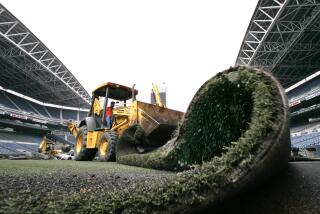Team Devises Way to Keep Grass Green
- Share via
CEDAR FALLS, Iowa — Golf courses, sod farms and suburban lawns could stay greener with technology developed by a team of retired Deere & Co. engineers.
With the help of a local engineering firm, the five-member team has invented a machine that injects liquid polymer into grass turf. The petroleum-based polymer helps grass retain moisture at its roots, reducing the need for water.
“A Phoenix golf course spent $830,000 on water last year. We know we can cut its water bill in half,” said Johnny Dickinson, spokesman for San Diego-based American Soil Technologies Inc., which owns the as-yet-unnamed machine.
AST has been marketing its polymer technology to farmers but believes the same technology will make grass thrive.
On farmland, AST’s Agriblend -- a granular mixture of polymers and zeolite clay -- is incorporated into the soil with a disc. On turf, there was no feasible way to inject polymers.
Dickinson, a retired Deere marketing executive, posed the problem to some former co-workers over coffee in August 2002. Late last month, they started testing the prototype.
The group, led by Gordon Wiegardt, built a machine with a large plastic tank to hold the polymer and nine independent rollers with 216 knives to inject it 3 inches into the ground.
The machine, pulled by a small tractor, cuts a 54-inch swath and covers 2 to 3 acres per hour.
“It will follow rough terrain, like on a golf course, and is still maneuverable,” Wiegardt said. “It was quite a challenge with so many close tolerances.”
“It’s one of a kind. There’s three to six patents already pending,” Dickinson said.
AST wouldn’t provide exact numbers but said several hundred thousand dollars went into the project.
“We’re thrilled with what we have here. This kind of talent and capability isn’t available [in California],” Dickinson said.
In February, it will be unveiled at the National Golf Superintendents Show in San Diego.
Treatment costs aren’t yet available, but Dickinson said it would probably cost a few thousand dollars per acre. That’s a bargain, he said, when treatments are needed only every three years.
The big money will come when the machine eventually is mass produced and sold to lawn care companies, industrial complexes and others with large expanses of grass.
“That’s who we expect to buy this machine,” Dickinson said. “We don’t expect a golf course to buy one but a company who takes care of several courses.”
More to Read
Inside the business of entertainment
The Wide Shot brings you news, analysis and insights on everything from streaming wars to production — and what it all means for the future.
You may occasionally receive promotional content from the Los Angeles Times.










